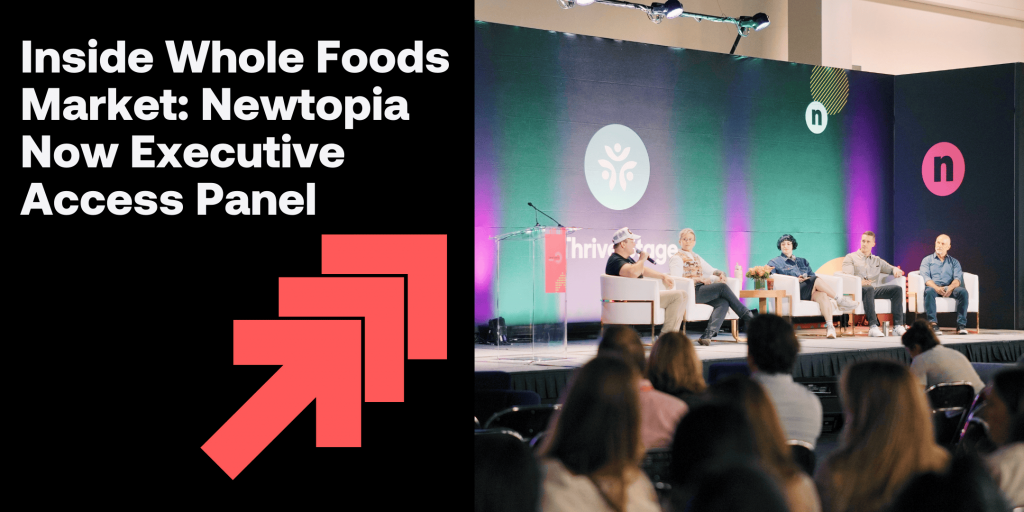Inside Whole Foods Market: Executive Access Panel Recap @ Newtopia Now
It’s no secret that Whole Foods Market is a dream retailer for natural product CPG brands all over the country – and even the world. At Newtopia Now 2025, Startup CPG’s founder, Daniel Scharff, brought us inside the minds of Whole Foods Market executives and asked them the questions we all want to know.
Learn how they evaluate products, what makes them say yes, and the specific programs they use to support emerging brands. This panel covered their LEAP accelerator, lending program, and much, much more!
Featured panelists:
- Casey Gaston, Executive Leader – Supplements
- Ben Bristol, Executive Leader – Dairy
- Kelly Landrieu, Local and Emerging Accelerator Program (LEAP) lead
- Scott Collier, VP – Business Development

How Whole Foods Market is Defining Innovation
If you think your product is innovative – keep these points in mind. According to the team, innovation must be disruptive, not just new. Innovation introduces new ways products are consumed, made, or produced while answering customer needs they may not have voiced yet.
Recognition signals for innovative products:
- Makes merchants lean in and ask follow-up questions
- Creates 30-minute conversations about the concept
- Brings incremental sales or new customers to the category
Innovative areas in dairy:
- Sourcing stories and supply chain
- Production methods
- Ingredient innovation (including removal)
- Cleaner labels through better formulation
Current Trends
Supplements:
- Food-supplement boundary blurring
- Nutrient density focus – customers want to know benefits they’ll receive if they consume your products
- Transparency through meaningful certifications and science-backed claims
- Whole food ingredients in supplementation
Broader trends:
- Protein surging (plant and animal-based)
- Digestive wellness across categories
- Every ingredient must provide nutritional benefit
- Products fitting dietary preferences and health goals
Decision Making: Data + Intuition
Data components:
- Market trends and consumer feedback
- Store team member insights
- Sales analytics
- Customer segment understanding
Intuitive elements:
- “Hard-earned intuition” from industry experience
- Personal consumer experiences
- Category expertise and competitive knowledge
Partnership Pathways
Before Approaching Whole Foods here are some things you should consider for yourself and your brand.
Self-assessment questions:
- Can you support targeted store count alongside direct-to-consumer business?
- Do you have clear channel strategy for managing multiple retailers?
- Can you protect and grow different retail relationships simultaneously?
- Do you have team covering finance, marketing, operations?
Infrastructure red flags for the WFM team: Passionate founders lacking P&L understanding, clear marketing plans, or proper support team.
Path Examples
National-ready indicators:
- Vertically integrated operations (own farms/facilities)
- Substantial capital backing
- Experienced teams with retail industry knowledge
- Example: Truvani (founder with established natural foods industry connections and infrastructure)
Local start benefits:
- Test operational capabilities in controlled environment
- Learn brick-and-mortar retail dynamics vs. direct-to-consumer
- Build understanding of Whole Foods systems
- Example: Sam+Leo (learned distribution and supply chain through accelerator program)
Support Programs
LEAP Accelerator
Two tracks: Early growth (new to Whole Foods) and on the verge (existing suppliers)
- 10 brands participate on each track annually
- 1,600+ applications for early growth
Early growth benefits:
- 13-16 week curriculum
- $25,000 investment
- Dedicated forager support
- NIQ buyer platform access for 1 year
Selection criteria:
- Adaptable, resilient founders willing to learn
- Retail-ready products bringing incremental value
- Right timing with market trends
Lending Program
- 4-6% APR corporate lending
- $5M+ deployed last year
- Must be existing supplier
- Can work with other lenders
- Sized based on Whole Foods growth potential
Applications: LEAP; Lending Program
What Merchants Actually Do
Time allocation: ~50% on innovation and new product evaluation
Beyond product evaluation:
- Complete sourcing stories
- Farmer/producer relationships
- Scientific backing
- Supply chain transparency
- Brand consistency
Best part of job: Farm and facility visits for education – the team is just as excited to visit you as you are to host them!
Critical Success Factors
Customer Focus
- Whole Foods is the channel, not the customer
- Focus on who pulls products off shelves
- Successful products get expanded, not removed
Required Transparency
- Open communication about needs and capabilities
- Honest assessment of business stage
- Clear capital requirements and growth plans
Relationship Management
- Relationship-based business with human schedules
- Be concise in communications
- Provide necessary information efficiently
- Don’t take delays personally
Internal Collaboration
Teams work together on:
- Brand assessment across categories
- Trend identification and opportunities
- Growth potential evaluation
- Capital needs matching
Realistic Expectations
- Rejection often means “not yet,” not “never”
- Very few brands succeed on first attempt
- Persistence and improvement valued over time
Taking Initiative
- Use resources like Startup CPG community (it’s FREE to join!)
- Leverage LinkedIn for connections
- Find mentorship and educational programs
- Take responsibility for brand growth
We hope this gives you a simplified overview of what went down on the panel with Whole Foods Market — good luck to all brands dreaming of having space on their shelves!
About Startup CPG
Startup CPG is the biggest community in the world for emerging brands. We have a reach of 135K+, over 25k members in our Startup CPG Slack, and create millions of impressions per month. We host the #1 world podcast in CPG, 100+ events per year, the industry’s largest free award program, and will do anything to help brands grow and shine. It’s free — join today!






All Comments